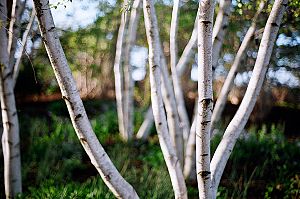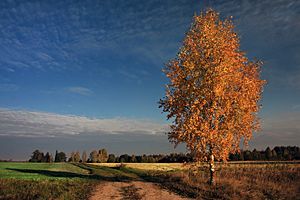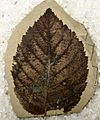Birch facts for kids
Quick facts for kids Birch |
|
|---|---|
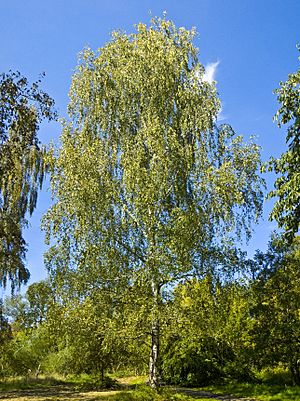 |
|
| Silver birch | |
| Scientific classification | |
| Kingdom: | |
| (unranked): | |
| (unranked): | |
| (unranked): | |
| Order: | |
| Family: | |
| Genus: |
Betula
|
| Birch |
|
|---|---|
 |
|
| Silver birch | |
| Scientific classification |
|
| Kingdom: | Plantae |
| Clade: | Tracheophytes |
| Clade: | Angiosperms |
| Clade: | Eudicots |
| Clade: | Rosids |
| Order: | Fagales |
| Family: | Betulaceae |
| Subfamily: | Betuloideae |
| Genus: | Betula L. |
| Subgenera | |
|
|
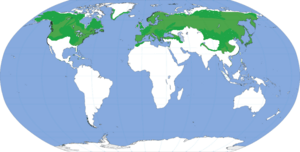 |
|
| Range of Betula | |
| Synonyms | |
|
|
Birch trees belong to the genus Betula. They are a type of deciduous hardwood tree in the Betulaceae family. This family also includes trees like alders, hazels, and hornbeams. Birches are also related to the beech-oak family, called Fagaceae.
There are about 30 to 60 different kinds of birch trees known. Some of these are even on the IUCN Red List of Threatened Species. Birches usually don't live very long. They are often the first trees to grow in new or disturbed areas. You can find them all over the Northern Hemisphere, especially in cool and cold places.
What Birches Look Like
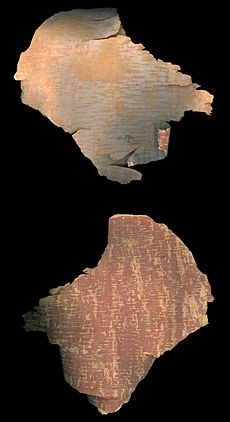
Birch trees are usually small to medium-sized trees or shrubs. They mostly grow in cool and cold parts of the world. Their leaves are simple and grow alternately on the branch. They often have jagged edges and veins that look like feathers.
The fruit of a birch tree is a small, winged seed called a samara. These seeds are released when the female catkins (flower clusters) break apart. This is different from alders, whose female catkins are woody and stay together.
The bark of birch trees is very special. It has long, horizontal marks called lenticels. Often, the bark peels off in thin, papery layers. This is especially true for the paper birch. The bark colors give many birches their common names, like gray, white, black, silver, and yellow birch.
Birch buds grow early in the summer. The wood of all birch species is fine-grained and has a smooth, shiny texture. It can be polished nicely and burns well.
Flowers and Fruits
Birch trees have both male and female flowers on the same tree. These flowers appear as catkins (long, hanging clusters). They open around the same time the leaves grow. Male catkins hang down, while female catkins stand upright or hang. Each female flower produces a small, winged nut.
Birch Families
Different Kinds of Birches
Scientists group Betula species into five main subgenera, which are like smaller families. Here are some examples of birch trees found around the world:
- Betula albosinensis – Chinese red birch (found in China)
- Betula alnoides – alder-leaf birch (found in China, Himalayas)
- Betula ermanii – Erman's birch (found in Siberia, Japan)
- Betula grossa – Japanese cherry birch (found in Japan)
- Betula nana – dwarf birch (found in Europe, Russia, Canada)
- Betula pendula – silver birch (common in Europe and Asia)
- Betula papyrifera – paper birch, also called canoe birch (found in North America)
- Betula alleghaniensis – yellow birch (found in eastern North America)
- Betula lenta – sweet birch, also called cherry birch or black birch (found in eastern US)
- Betula nigra – river birch or black birch (found in eastern US)
Where the Name Comes From
The word "birch" comes from an old English word, birce. It's related to words in other languages like German (Birke) and Danish (birk). Many believe the word comes from an ancient root meaning "to shine" or "whiten." This makes sense because of the birch's bright white bark. The old Germanic rune berkanan is even named after the birch tree.
The scientific name Betula comes from Latin. It's a smaller version of a Gaulish word, betua.
Birch in Nature
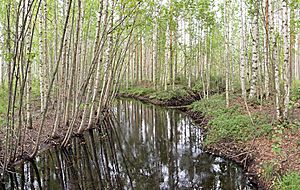
Birch trees often grow together in groups, especially in areas with light, well-drained, and slightly acidic soils. They are known as "pioneer species." This means they are among the first trees to grow in open areas, like after a forest fire or when land has been cleared. They can quickly take over these spaces.
Some birch species, like the dwarf birch, grow in mountain areas. In the British Isles, different types of birches grow in slightly different places.
Birch trees can also benefit from special fungi called mycorrhizal fungi. These fungi help the trees grow better. Many different kinds of insects, especially moths and butterflies, like to eat birch leaves.
How People Use Birches
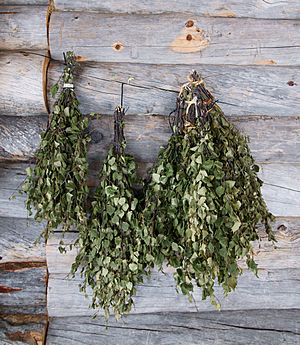
Birch wood is strong and pale, often with a lovely shiny look. Sometimes, the wood has wavy patterns, which makes it very valuable for furniture.
- Plywood: Birch plywood is made by gluing many thin layers of birch wood together. It's light but very strong and stable. It's used for many things, including longboards and model aircraft.
- Extracts: Parts of birch trees are used to add flavor or to make leather oil. They are also found in cosmetics like soap and shampoo. In the past, a type of oil called wintergreen oil was made from the sweet birch.
- Birch-tar: This sticky, waterproof substance comes from birch bark. Long ago, it was used as a glue for things like arrows. It was also used for medicine.
- Twigs: Fragrant birch twigs are used in saunas, especially in Finland.
- Decorations: In Central and Eastern Europe, birch branches are used to decorate churches and homes for the Pentecost holiday.
- Boat Sails: Ground birch bark, mixed with sea water, was used to treat the sails and ropes of traditional Norwegian boats. This made them last longer.
- Firewood: Birch wood is great for firewood. It burns well, even when wet or frozen, because of the oils in its bark. The bark can also be easily split into thin pieces that catch fire quickly. Birch wood is also used to smoke foods.
- Leather: Birch oil is used to make Russia leather, which is a type of water-resistant leather.
- Native American Uses: Many Native Americans in the United States and Indigenous peoples in Canada value birch bark. It's light, flexible, and easy to remove from fallen trees. They used it to build strong, waterproof, and lightweight canoes, bowls, and wigwams.
- Aircraft: The famous Hughes H-4 Hercules airplane, also known as "The Spruce Goose," was mostly made from birch wood.
- Musical Instruments: Birch wood is popular for making speaker cabinets because it helps sound good. It's also often used for drums and sometimes for acoustic guitar bodies.
Growing Birches
White-barked birches are often grown as ornamental trees because they look beautiful, especially in winter. The Himalayan birch, Betula utilis, is a very popular choice for this. Many different types of this birch are grown, like 'Doorenbos' and 'Silver Shadow'. Other white-barked birches grown for their beauty include Betula ermanii and Betula papyrifera.
Medical Uses
Birch bark has been used for a long time in traditional medicine.
- Skin Wounds: In Europe, a special gel made from birch bark extract is approved to help heal minor skin wounds. It seems to help skin cells grow to fill the wound.
- Traditional Healing: For centuries, indigenous people in North America used birch bark directly on the skin to treat small wounds. In the 16th century, splints made from birch bark were even used like casts for broken bones.
Paper from Birch
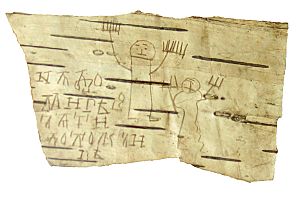
Wood pulp from birch trees has long, thin fibers. These fibers make paper that is not very thick or opaque. This low opacity makes it good for making a special type of paper called glassine.
In India, birch bark (called bhurja) was very important long ago. People used the thin bark that peeled off in winter as writing paper. Many ancient Indian texts were written on this durable birch paper. The ancient Roman Vindolanda tablets also used birch for writing. In ancient Russia, birch bark (byeryesta) was used for notes, decorations, and even for making footwear and baskets.
Birch in Culture
Birch trees are important in many cultures and religions. In Celtic cultures, the birch stands for growth, new beginnings, and strength. This is because it can grow well even in tough conditions and quickly regrow after fires. Birches are also linked to the Tír na nÓg, a mythical land, and often appear in old songs and stories about death or fairies.
The birch is the state tree of New Hampshire in the USA. It is also the national tree of Finland and Russia. The yellow birch is the official tree of Quebec, Canada. In Russia, the birch is a very important symbol. It represents the beauty of Russian women and the strong connection Russians have to nature. Many Russian folk songs feature the birch tree. The Ornäs birch is the national tree of Sweden.
The Czech word for March, Březen, comes from the Czech word for birch, bříza. This is because birch trees bloom in March in that region. The silver birch is very special to the city of Umeå in Sweden. After a big fire in 1888 almost destroyed the city, birch trees were planted along wide avenues. People believed these trees helped stop the fire from spreading. Because of this, Umeå is unofficially called "City of the Birches." The city's ice hockey team is even called Björklöven, which means "The Birch Leaves."
In the 1800s, American children often played a game called "swinging" on birch trees. The poet Lucy Larcom wrote a poem about this game. This poem later inspired the famous American poet Robert Frost to write his well-known poem, "Birches." Frost once said it felt almost wrong to bend a birch tree until it touched the ground, but that's what boys did back then.
Images for kids
-
Fossil leaf of Betula leopoldae
See also
 In Spanish: Betula para niños
In Spanish: Betula para niños



